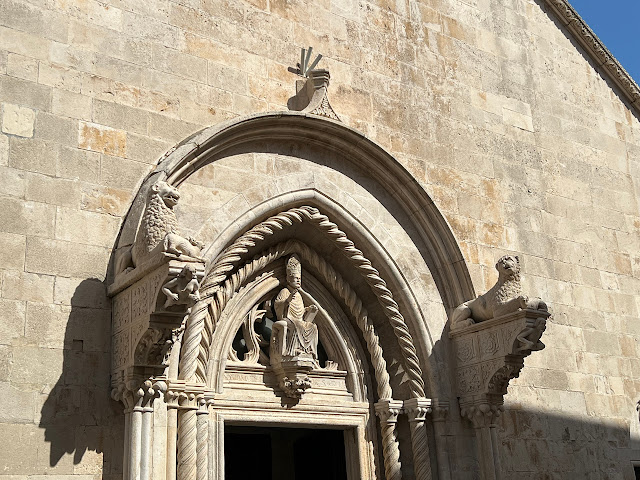 |
| Medieval city walls and towers of Korcula, Croatia |
Tuesday, July 5 - Trip Day 6
This afternoon we traveled in the Sea Cloud tenders to the port of Korcula. It's pronounced Kor-Choo-la, as when written in Croatian, there is a little curved mark under the "c" which means a "ch" sound.
The island of Korcula is about 20 miles long - the sixth largest in Croatia. The medieval town of Korcula is it's most visited site - a jewel of a town built on a peninsula wrapped around with well preserved stone walls. Korcula is famous as the birthplace of Marco Polo.
Korcula's streets are pedestrian only and constructed like a fishbone. A main road runs along the center, with streets running off to each side, like the bones of a fish. They are built to take advantage of the summer breezes and to limit the winter winds.
We began our time in Korcula with a tour of the old town, led by Jana. She was skilled at finding us shade for our visit, as the temperatures were again in the high 90's. We walked along the top of the town walls, which are a wide pedestrian path, lined with trees, cafes and shops. There were enticing views across the channel to the Peljesac peninsula. The deep cerulean colors of the sea made the blue sky look pale.
We stopped to visit the location that claims itself as the birthplace of Marco Polo. There is some documentary evidence that the house was owned by the diPolo family, but Venice refuted that Marco Polo is Croatian. Of course, at the time, it was Dalmatia and all part of the Venetian Republic. There wasn't really anything to see, other than a gift shop. So, we will let it remain a mystery.
We visited Korcula's cathedral, the Roman Catholic Cathedral of St. Mark. There is exuberant stone carving decorating both the exterior and interior of the complex. Venetian craftsmen were hired for much of the artistic detail. In fact, the painting over the altar was done by Tintoretto. The Cathedral was built and completed in the 15th and 16th centuries
 |
| At our port landing, we had an excellent view of Korcula's medieval walls and towers |
 |
| The Zakerjan Tower, from the 13th century, and its associated beach |
 |
| Our guide, Jana, and Michael, beating the heat in the shade |
 |
| The Governor's Tower |
We began our time in Korcula with a tour of the old town, led by Jana. She was skilled at finding us shade for our visit, as the temperatures were again in the high 90's. We walked along the top of the town walls, which are a wide pedestrian path, lined with trees, cafes and shops. There were enticing views across the channel to the Peljesac peninsula. The deep cerulean colors of the sea made the blue sky look pale.
 |
| Walking along the top of Korcula's old town stone walls |
 |
| The shaded cafes that lined the walkways helped mitigate the summer heat |
 |
| The colors of the Adriatic Sea!! |
We stopped to visit the location that claims itself as the birthplace of Marco Polo. There is some documentary evidence that the house was owned by the diPolo family, but Venice refuted that Marco Polo is Croatian. Of course, at the time, it was Dalmatia and all part of the Venetian Republic. There wasn't really anything to see, other than a gift shop. So, we will let it remain a mystery.
 |
| Ulica Dipolo - Street of Polo |
 |
| A view of the city wall and tower from the location of the Marco Polo house |
 |
| A gift shop marks the location of the reputed birthplace of Marco Polo |
We visited Korcula's cathedral, the Roman Catholic Cathedral of St. Mark. There is exuberant stone carving decorating both the exterior and interior of the complex. Venetian craftsmen were hired for much of the artistic detail. In fact, the painting over the altar was done by Tintoretto. The Cathedral was built and completed in the 15th and 16th centuries
 |
| Exterior of Korcula's Cathedral of Saint Mark |
 |
| The cathedral's stone portico was carved by Bonino da Milano |
 |
| A most interesting and complex drainage spout! |
 |
| The interior - with the Tintoretto altar piece to the left over the shoulder of our guide |
 |
| More great stone carvings - looks like good has vanquished evil, yes? |
 |
| Serene and captivating |
 |
| Michael opts out of the tour - too hot for him to look at church artifacts |
 |
| Town square - old town Korcula |
 |
| St. Michael's Church, on the main town square, near the entrance gate of the city walls |
 |
| Interior of the All Saint's Church, which hosts the city's oldest brotherhood |
 |
| Pieta at the altar of the All Saint's Church |
 |
| Carved by Austrian artist Georg Raphael Donner in the 18th century |
 |
| The Arch of the Venetian Foscolo (1651) on the Revelin Tower of the city gate |
No comments:
Post a Comment